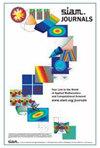多保真度重要抽样和贝叶斯反问题中平衡近似和抽样代价的上下文感知代理建模
IF 1.9
3区 工程技术
Q2 MATHEMATICS, INTERDISCIPLINARY APPLICATIONS
引用次数: 7
摘要
多保真度方法利用低成本的代理模型来加快计算速度,并偶尔求助于昂贵的高保真度模型来建立准确性保证。由于代理模型和高保真度模型被一起使用,代理模型的糟糕预测可以通过频繁求助于高保真度模型来弥补。因此,在投入计算资源以提高代理模型的准确性与简单地更频繁地求助于昂贵的高保真模型之间存在权衡;然而,这种权衡被传统的建模方法所忽略,这些建模方法构建替代高保真模型的代理模型,而不是与高保真模型一起使用。这项工作考虑了多保真度重要采样,并在理论上和计算上权衡了增加代理模型的保真度以构建更精确的偏倚密度和从高保真度模型中补偿差偏倚密度所需的样本数量。数值示例表明,这种用于多保真度重要性采样的上下文感知代理模型的保真度低于传统模型简化中通常设置的公差,从而导致所提供示例中的运行时加速高达一个数量级。本文章由计算机程序翻译,如有差异,请以英文原文为准。
Context-Aware Surrogate Modeling for Balancing Approximation and Sampling Costs in Multifidelity Importance Sampling and Bayesian Inverse Problems
Multifidelity methods leverage low-cost surrogate models to speed up computations and make occasional recourse to expensive high-fidelity models to establish accuracy guarantees. Because surrogate and high-fidelity models are used together, poor predictions by surrogate models can be compensated with frequent recourse to high-fidelity models. Thus, there is a trade-off between investing computational resources to improve the accuracy of surrogate models versus simply making more frequent recourse to expensive high-fidelity models; however, this trade-off is ignored by traditional modeling methods that construct surrogate models that are meant to replace high-fidelity models rather than being used together with high-fidelity models. This work considers multifidelity importance sampling and theoretically and computationally trades off increasing the fidelity of surrogate models for constructing more accurate biasing densities and the numbers of samples that are required from the high-fidelity models to compensate poor biasing densities. Numerical examples demonstrate that such context-aware surrogate models for multifidelity importance sampling have lower fidelity than what typically is set as tolerance in traditional model reduction, leading to runtime speedups of up to one order of magnitude in the presented examples.
求助全文
通过发布文献求助,成功后即可免费获取论文全文。
去求助
来源期刊

Siam-Asa Journal on Uncertainty Quantification
Mathematics-Statistics and Probability
CiteScore
3.70
自引率
0.00%
发文量
51
期刊介绍:
SIAM/ASA Journal on Uncertainty Quantification (JUQ) publishes research articles presenting significant mathematical, statistical, algorithmic, and application advances in uncertainty quantification, defined as the interface of complex modeling of processes and data, especially characterizations of the uncertainties inherent in the use of such models. The journal also focuses on related fields such as sensitivity analysis, model validation, model calibration, data assimilation, and code verification. The journal also solicits papers describing new ideas that could lead to significant progress in methodology for uncertainty quantification as well as review articles on particular aspects. The journal is dedicated to nurturing synergistic interactions between the mathematical, statistical, computational, and applications communities involved in uncertainty quantification and related areas. JUQ is jointly offered by SIAM and the American Statistical Association.
 求助内容:
求助内容: 应助结果提醒方式:
应助结果提醒方式:


